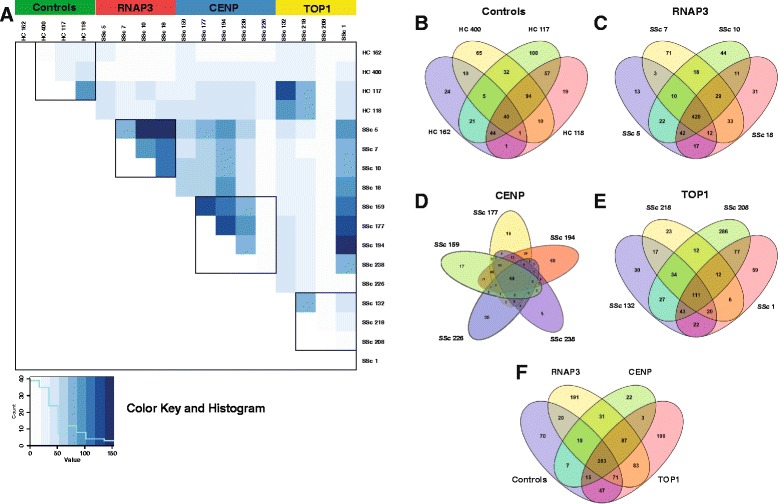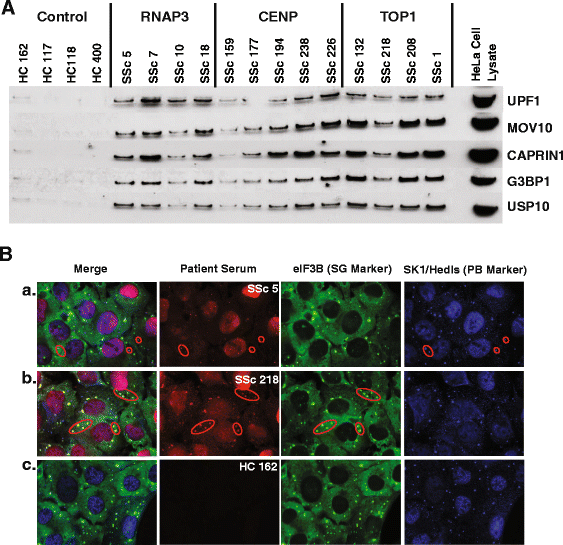Stress granules and RNA processing bodies are novel autoantibody targets in systemic sclerosis
- PMID: 26801089
- PMCID: PMC4724133
- DOI: 10.1186/s13075-016-0914-4
Stress granules and RNA processing bodies are novel autoantibody targets in systemic sclerosis
Abstract
Background: Autoantibody profiles represent important patient stratification markers in systemic sclerosis (SSc). Here, we performed serum-immunoprecipitations with patient antibodies followed by mass spectrometry (LC-MS/MS) to obtain an unbiased view of all possible autoantibody targets and their associated molecular complexes recognized by SSc.
Methods: HeLa whole cell lysates were immunoprecipitated (IP) using sera of patients with SSc clinically positive for autoantibodies against RNA polymerase III (RNAP3), topoisomerase 1 (TOP1), and centromere proteins (CENP). IP eluates were then analyzed by LC-MS/MS to identify novel proteins and complexes targeted in SSc. Target proteins were examined using a functional interaction network to identify major macromolecular complexes, with direct targets validated by IP-Western blots and immunofluorescence.
Results: A wide range of peptides were detected across patients in each clinical autoantibody group. Each group contained peptides representing a broad spectrum of proteins in large macromolecular complexes, with significant overlap between groups. Network analyses revealed significant enrichment for proteins in RNA processing bodies (PB) and cytosolic stress granules (SG) across all SSc subtypes, which were confirmed by both Western blot and immunofluorescence.
Conclusions: While strong reactivity was observed against major SSc autoantigens, such as RNAP3 and TOP1, there was overlap between groups with widespread reactivity seen against multiple proteins. Identification of PB and SG as major targets of the humoral immune response represents a novel SSc autoantigen and suggests a model in which a combination of chronic and acute cellular stresses result in aberrant cell death, leading to autoantibody generation directed against macromolecular nucleic acid-protein complexes.
Figures



Similar articles
-
Brief Report: Anti-Eukaryotic Initiation Factor 2B Autoantibodies Are Associated With Interstitial Lung Disease in Patients With Systemic Sclerosis.Arthritis Rheumatol. 2016 Nov;68(11):2778-2783. doi: 10.1002/art.39755. Arthritis Rheumatol. 2016. PMID: 27273608
-
Characterization of antinucleolar antibody reactivity in patients with systemic sclerosis and their relatives.J Rheumatol. 1997 Mar;24(3):477-84. J Rheumatol. 1997. PMID: 9058652
-
Interpretation of an Extended Autoantibody Profile in a Well-Characterized Australian Systemic Sclerosis (Scleroderma) Cohort Using Principal Components Analysis.Arthritis Rheumatol. 2015 Dec;67(12):3234-44. doi: 10.1002/art.39316. Arthritis Rheumatol. 2015. PMID: 26246178
-
Bicaudal D2 is a novel autoantibody target in systemic sclerosis that shares a key epitope with CENP-A but has a distinct clinical phenotype.Autoimmun Rev. 2018 Mar;17(3):267-275. doi: 10.1016/j.autrev.2018.01.006. Epub 2018 Jan 31. Autoimmun Rev. 2018. PMID: 29369808 Review.
-
Autoantibodies to the mitochondrial RNA processing (MRP) complex also known as Th/To autoantigen.Autoimmun Rev. 2015 Mar;14(3):254-7. doi: 10.1016/j.autrev.2014.11.007. Epub 2014 Nov 15. Autoimmun Rev. 2015. PMID: 25462581 Review.
Cited by
-
Toll-Like Receptor Mediated Activation of Natural Autoantibody Producing B Cell Subpopulations in an Autoimmune Disease Model.Int J Mol Sci. 2019 Dec 6;20(24):6152. doi: 10.3390/ijms20246152. Int J Mol Sci. 2019. PMID: 31817576 Free PMC article.
-
Stress Granules Involved in Formation, Progression and Metastasis of Cancer: A Scoping Review.Front Cell Dev Biol. 2021 Sep 17;9:745394. doi: 10.3389/fcell.2021.745394. eCollection 2021. Front Cell Dev Biol. 2021. PMID: 34604242 Free PMC article.
-
Analysis of PI3K Pathway Associated Molecules Reveals Dysregulated Innate and Adaptive Functions of B Cells in Early Diffuse Cutaneous Systemic Sclerosis.Int J Mol Sci. 2021 Mar 12;22(6):2877. doi: 10.3390/ijms22062877. Int J Mol Sci. 2021. PMID: 33809015 Free PMC article.
-
Arginine Demethylation of G3BP1 Promotes Stress Granule Assembly.J Biol Chem. 2016 Oct 21;291(43):22671-22685. doi: 10.1074/jbc.M116.739573. Epub 2016 Sep 6. J Biol Chem. 2016. PMID: 27601476 Free PMC article.
-
Stress Granule Assembly in Pulmonary Arterial Hypertension.Cells. 2024 Oct 30;13(21):1796. doi: 10.3390/cells13211796. Cells. 2024. PMID: 39513903 Free PMC article.
References
Publication types
MeSH terms
Substances
Grants and funding
LinkOut - more resources
Full Text Sources
Other Literature Sources
Medical
Research Materials

